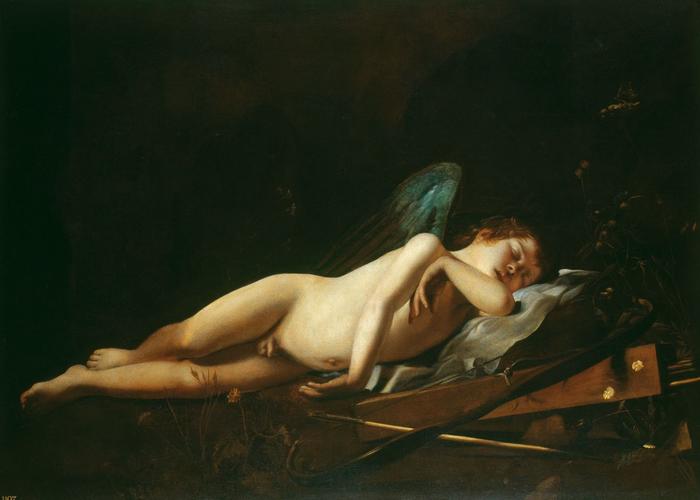Cupid Sleeping c.1618
Oil on canvas | 92.3 x 127.1 cm (support, canvas/panel/stretcher external) | RCIN 405747
-
The winged boy-god of love sleeps; his bow and arrows lie idle while flowers grow around him. The message is that we are only safe from Cupid's mischief when he sleeps. Caracciolo's inspiration here would seem to be Caravaggio's own version of the subject (Palazzo Pitti, Florence).
The subject of the Sleeping Cupid owed much of its popularity to a youthful sculpture by Michelangelo, a copy of a Hellenistic marble which he passed off as a genuine antiquity. Interest in this forgery, and the theme in general, arose especially in the circle of Caravaggio. In this example the winged boy-god of love sleeps; his bow and arrows lie idle, while flowers seem to spring up around him. The idea is simple: Cupid is supremely mischievous; we are only safe when he sleeps. This joke was given an allegorical dimension in the literature and art of the period, and came to mean that tranquillity of mind can only be achieved by controlling the passions (that is, by 'putting Cupid to sleep'). This idea went back to classical times, when Cupid was linked to Hypnos, the Roman god of sleep, and occasionally depicted on Roman sepulchres in an allusion to the peaceful repose of the dead.
Caracciolo's immediate source of inspiration here would seem to be Caravaggio's version of the subject in the Pitti Palace in Florence, painted in Malta in 1608 and recorded in the collection of Francesco dell'Antella in Florence in 1609. It seems probable that Caracciolo saw Caravaggio's painting during his Florentine sojourn in 1618. There are notable differences between the two treatments of the same subject. For example, Caracciolo's Cupid is a slim boy with elongated limbs, while Caravaggio's is a round baby with full cheeks. This fundamental change, as well as the idyllic landscape filled with flowers and a butterfly, gives the Royal Collection painting a more refined and elegant character.
A 'Sleeping Amor' was mentioned in the 1627 inventory of the Gonzaga collection in Mantua, from which it was likely to have been bought by Charles I; it was sold for £15 on 30 April 1650 as a Caravaggio. Following the Restoration it was recovered for the monarchy and hung in Whitehall. Between 1676 and 1677, Nicolas de Largilliere, who worked at Windsor Castle under the direction of Antonio Verrio, is recorded as restoring the Sleeping Cupid to the satisfaction of Charles II. According to Dézallier D'Argenville in 1762 he 'completely repainted the legs, which had become damaged by time'. This accords with the evidence gathered from x-radiography in which damage to the legs is visible but has been expertly concealed by the work of an early restorer.
Catalogue entry adapted from The Art of Italy in the Royal Collection: Renaissance and Baroque, London, 2007Provenance
Recorded in the Gonzaga collection in 1627 and presumably bought by Charles I; valued at £15 by the Trustees for Sale and sold to Turbridge 20 April 1650 from Hampton Court (no 59); recovered at the Restoration and listed in the Long Matted Gallery at Whitehall in 1666 (no 64)
-
Medium and techniques
Oil on canvas
Measurements
92.3 x 127.1 cm (support, canvas/panel/stretcher external)
107.4 x 143.9 x 7.0 cm (frame, external)
Category
Object type(s)









